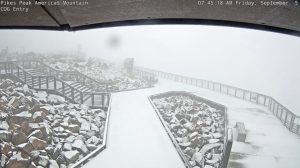Summit Outside: Indian paintbrush colors the county
Special to the Daily

ALL |
Indian paintbrush is another one of my favorite flowers, especially the red and magenta variety. They bloom all over our alpine environment and they seem especially brilliant and abundant this year. We are so lucky to be surrounded by such beauty in the summer.
“Castilleja,” commonly known as Indian paintbrush is native to the Americas and it is found from Alaska south to the Andes. It is named after the Spanish botanist Domingo Castillejo. Indian paintbrush may also be called “butterfly weed,” “prairie-fire” or “hawkweed” and is a member of the figwort family.
The plant grows in a variety of soils and can grow in semi-shade (light woodland) or in sunny locations from mid- to high elevations in forests, roadsides and slopes. It is easy to see why the plant received its name “paintbrush.” The tops look like they have been dipped in bright red paint. Dyes have been made from the Indian paintbrush plant.
One of the popular bright red paintbrushes grows 6-16 inches high, its several unbranched stems form clumps topped by bright-red, paintbrush-like spikes. The flowers are actually inconspicuous and greenish, but are subtended or lie underneath showy, red-tipped bracts which are a modified leaf that arises from the stem at the point where the flower develops. Together, the flowers and bracts form 3-8-inch spikes. They vary in color from orange and scarlet to cream and yellow. There are many species of paintbrush.
Paintbrush is seen growing with other flowers. They are considered hemiparasitic as they feed on the roots of grasses and forbs (broad-leafed herbaceous plants). The roots of this plant will grow until they touch the roots of other plants, frequently grasses, penetrating these host roots to obtain a portion of their nutrients. Since these plants use the roots of other plants to help them grow it is hard to transplant some paintbrush plants.
In some years, when bluebonnets (which flower at approximately the same time as Indian paintbrush) are especially colorful, paintbrush will have only an average flowering year. Other years, paintbrush is spectacular, and this might be because of the parasitism.
The flowers are hermaphrodite (have both male and female organs).
Castilleja are eaten by the larvae of some moths and butterflies. Because there are no places to perch on the paintbrush, the plant requires “hovering” insects and birds for pollination.
Indian paintbrush seed is so tiny you can plant a whole acre with several handfuls and there are millions of seeds in one pound!
The flowers of Indian paintbrush are edible and are said to be sweet tasting. They were added as condiment with other fresh greens, and consumed in moderation by various Native American tribes. Indian paintbrush has similar health benefits to consuming garlic if only the flowers are eaten in small amounts and in moderation.
These plants absorb and concentrate selenium in their tissues from the soils in which they grow, and can be potentially very toxic if the roots or green parts of the plant are consumed. Alkaline soils increase the selenium levels in the plants.
The Ojibwe made a hair wash from Indian paintbrush to make their hair glossy and full bodied. The plant has also been cited as a treatment for rheumatism and the selenium content of this plant may be a reason for its effectiveness. Nevada Indian tribes used the plant to treat sexually transmitted diseases and to enhance the immune system. A decoction made by boiling the leaves was used during pregnancy in order to keep the baby small and thus lead to an easier labor. When taken over a long period of time, a decoction of the root is said to be an effective treatment for venereal disease. The plant has also been used to treat skin diseases, kidney disorders, leprosy, in the treatment of excessive menstrual discharge and other menstrual difficulties, to prevent conception and to treat stomach aches.
According to Native Indian lore: “Now when the friendly plants heard what the animals had decided against mankind, they planned a counter motive of their own; each tree, shrub, herb, grass and moss agreed to furnish a cure for one of the diseases named by the animals and insects.”
Thousands of years of acquiring knowledge of plants and minerals by the native peoples has contributed greatly to pharmacological medicine. Plants must be used in precise amounts and exacting preparations however, or they can be toxic.
There is a children’s story called “The Legend of the Indian Paintbrush” by Tomie DePaola. This vivid retelling of an old Texas legend reveals how the Indian paintbrush – the state flower of Wyoming – first bloomed, and how a young brave dreamt of creating a painting that captured the beauty of a sunset.
“Little Gopher painted his masterpiece and when he got done he walked back to his tent, leaving the brushes strewn across the hillside. In the morning the brushes had multiplied and turned into flowers, and Little Gopher became known as He-Who-Brought-the-Sunset-to-the-Earth.”
The Indian paintbrush has captured the imagination of many. There is a production company called “Indian Paintbrush Productions,” a Colorado Springs guest house has an “Indian Paintbrush Suite.” There are roads and streets named “Indian Paintbrush.” There is the Indian Paintbrush Campground in Morrison and the list goes on.
Breckenridge resident Dr. Joanne Stolen is retired from teaching microbiology at Rutgers University. Some of the block prints of the animals she writes about can be seen locally. During the summer she coaches rowing at Frisco Rowing Center.

Support Local Journalism

Support Local Journalism
As a Summit Daily News reader, you make our work possible.
Summit Daily is embarking on a multiyear project to digitize its archives going back to 1989 and make them available to the public in partnership with the Colorado Historic Newspapers Collection. The full project is expected to cost about $165,000. All donations made in 2023 will go directly toward this project.
Every contribution, no matter the size, will make a difference.









